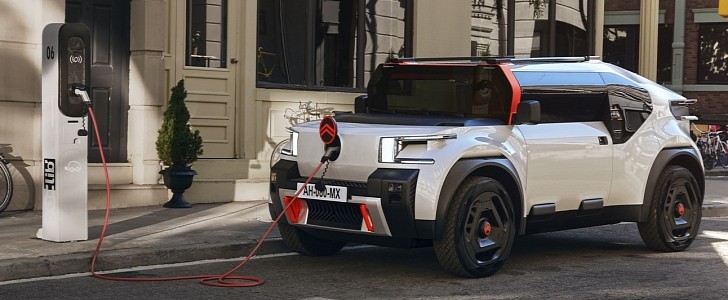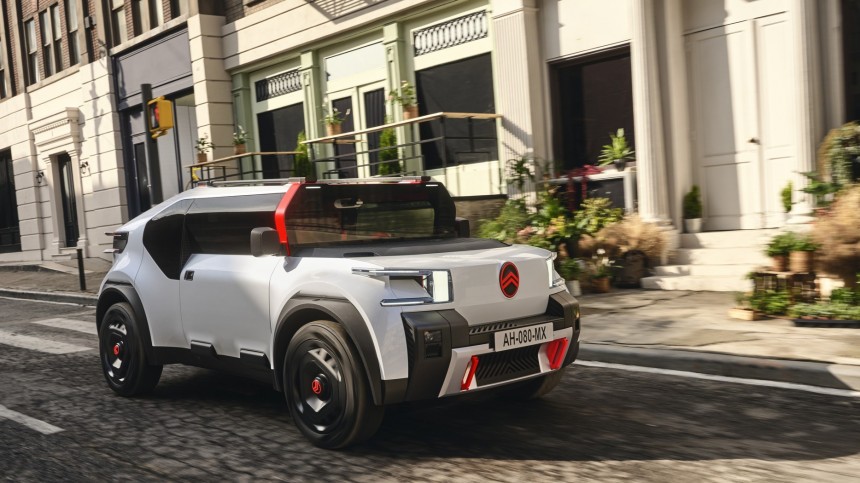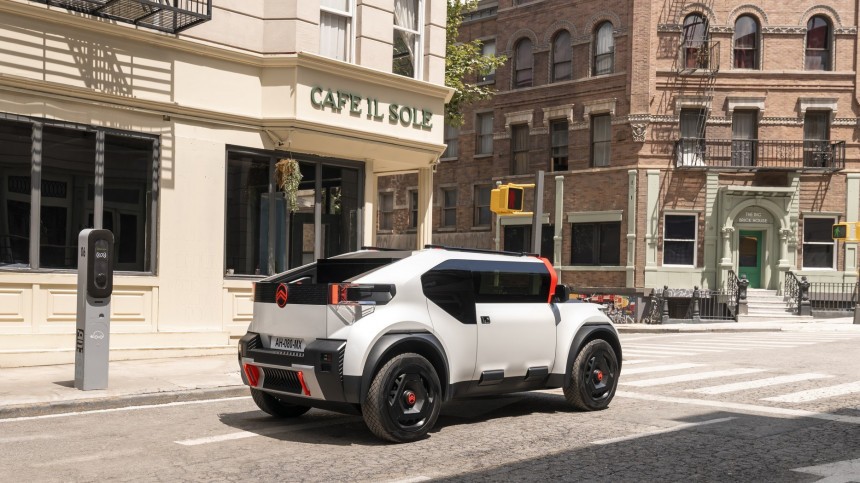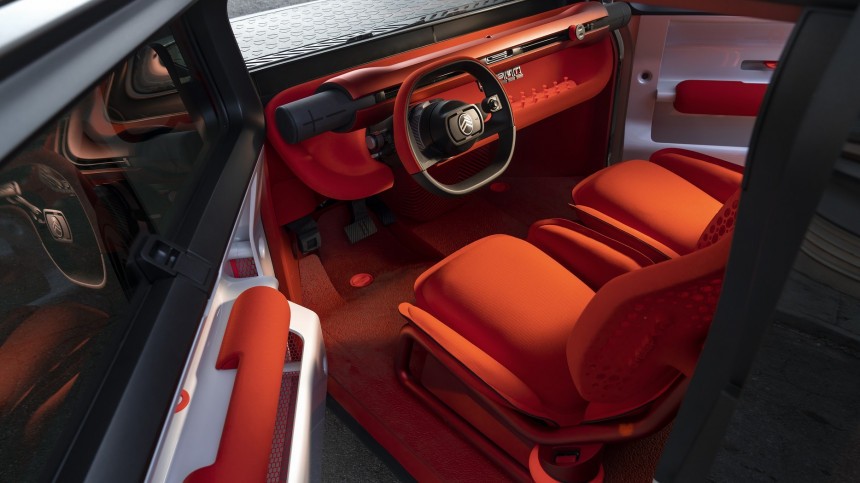Citroën recently decided it would have a nostalgic new badge, probably eager to recover what it was known for with the 2CV: offering comfortable, quirky, and affordable family cars. The concept vehicle in charge of presenting this new logo combines all three characteristics. It is hard to say which is the front end of the Citroën oli with a single look.
That happens because the front end is so square that it reminds us of the trunk of a 1970s sedan. Considering the EV is electric, that would undoubtedly bring a penalty in terms of aerodynamics if this vehicle had any chance of reaching production lines as it is.
The square lines have a good explanation: making interchangeable parts. Like the Ami, the oli has identical front doors. The rear doors seem to open rearward and are so small that a production car based on the concept vehicle would probably dismiss them. Apart from being cheaper to build, these identical doors also helped the oli reduce weight by 20% compared to those of a family hatchback. Bumpers, flat panels, glasses, and protective elements are also identical, which makes replacing them much more manageable.
Citroën intends to compensate for the boxy design aerodynamic disadvantage with a very ambitious weight target: only 1,000 kilograms (2,205 pounds). The oli has a top speed of 110 kph (68 mph) for “maximum efficiency.” In fact, the lower the speed, the less relevant the aerodynamic drag’s role is to energy consumption. That’s why electric cars do so much better in the urban environment.
To reach those mass goals, the Citroën oli uses very unconventional materials in its construction. The flat hood, roof, and rear bed are made of recycled honeycomb cardboard. The trick is that it is associated with fiberglass reinforcing panels. The French brand is proud that you can stand on these structures without fear of damaging them. The Smart Design Seat is another mass-saving measure: it presents only three components and is much lighter than a conventional seat.
With an energy consumption goal of 10 kWh/100 km (6.2 mi/kWh), the French concept car only needs a 40-kWh battery pack to achieve a range of 400 kilometers (249 miles). The little battery pack is crucial for the vehicle to remain as light as possible, which is essential for lower energy demand.
The interior also helps the oli save mass by offering only the basic. There are no screens anywhere: the instrument panel is shown by any smartphone connected to the EV. If you need to know the speed or the charge, the only way to find it apart from the mobile phone is what Citroën calls Smartband. It “projects information across the width of the lower windscreen surround.” You’ll get that by checking the video below.
Instead of having a conventional trunk, the oli has a small bed that would be useless for truck drivers if it was not for a midgate system that allows the driver to expand it. The good news for those worried about cargo privacy is that the concept car presents a trunk below the bed. With the smaller battery pack, there is room for cargo under the floor of the oli. In a vehicle with a larger battery pack, that space would be filled with cells.
The oli uses the 40-kWh to become more than a vehicle – even if Citroën says it is not a car. The vehicle-to-grid (V2G) and vehicle-to-load (V2L) capabilities turn it into a handy and massive power bank in emergency situations or just if you want the solar energy you generate to be stored instead of selling it to your power company.
For the first time in years, Citroën is making more than just giving another look and another badge for Peugeot products. The oli is a good sign that it may offer new solutions for old matters, something it was once famous for representing.
The square lines have a good explanation: making interchangeable parts. Like the Ami, the oli has identical front doors. The rear doors seem to open rearward and are so small that a production car based on the concept vehicle would probably dismiss them. Apart from being cheaper to build, these identical doors also helped the oli reduce weight by 20% compared to those of a family hatchback. Bumpers, flat panels, glasses, and protective elements are also identical, which makes replacing them much more manageable.
To reach those mass goals, the Citroën oli uses very unconventional materials in its construction. The flat hood, roof, and rear bed are made of recycled honeycomb cardboard. The trick is that it is associated with fiberglass reinforcing panels. The French brand is proud that you can stand on these structures without fear of damaging them. The Smart Design Seat is another mass-saving measure: it presents only three components and is much lighter than a conventional seat.
The interior also helps the oli save mass by offering only the basic. There are no screens anywhere: the instrument panel is shown by any smartphone connected to the EV. If you need to know the speed or the charge, the only way to find it apart from the mobile phone is what Citroën calls Smartband. It “projects information across the width of the lower windscreen surround.” You’ll get that by checking the video below.
The oli uses the 40-kWh to become more than a vehicle – even if Citroën says it is not a car. The vehicle-to-grid (V2G) and vehicle-to-load (V2L) capabilities turn it into a handy and massive power bank in emergency situations or just if you want the solar energy you generate to be stored instead of selling it to your power company.
For the first time in years, Citroën is making more than just giving another look and another badge for Peugeot products. The oli is a good sign that it may offer new solutions for old matters, something it was once famous for representing.










